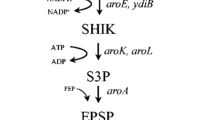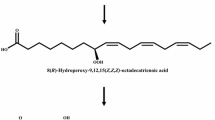Abstract
Acinetobacter sp. strain ST-550 produces indigo from indole in the presence of a large volume of diphenylmethane and a high level of indole. Particular proteins increased remarkably in strain ST-550 grown in the two-phase culture system for indigo production. One of the proteins showed a N-terminal amino acid sequence that was identical to that of the largest subunit of phenol hydroxylase (MopN) from A. calcoaceticus NCBI8250. The indigo-producing activity was strongly induced when ST-550 was grown with phenol as a sole carbon source. Genes coding for the multicomponent phenol hydroxylase were cloned, based on the homology with mopKLMOP from A. calcoaceticus NCBI8250. Escherichia coli carrying the genes produced indigo from indole. E. coli JA300 and its cyclohexane-resistant mutant, OST3410, carrying the hydroxylase genes and the NADH regeneration system were grown in the two-phase culture system for indigo production. The OST3410 recombinant produced 52 µg indigo ml–1 of medium in the presence of diphenylmethane. This productivity was 4.3-fold higher than that of the JA300 recombinant.



Similar content being viewed by others
References
Aono R, Aibe A, Inoue A, Horikoshi K (1991) Preparation of organic solvent-tolerant mutants from Escherichia coli K-12. Agric Biol Chem 55:1935–1938
Aono R, Kobayashi M, Nakajima H, Kobayashi H (1995) A close correlation between improvement of organic solvent tolerance levels and alteration of resistance toward low levels of multiple antibiotics in Escherichia coli. Biosci Biotechnol Biochem 59:213–218
Bradford MM (1976) A rapid and sensitive method for the quantitation of microgram quantities of protein utilizing the principle of protein–dye binding. Anal Biochem 72:248–254
Doukyu N, Aono R (1997) Biodegradation of indole at high concentration by persolvent fermentation with Pseudomonas sp. ST-200. Extremophiles 1:100–105
Doukyu N, Arai T, Aono R (1998) Effects of organic solvents on indigo formation by Pseudomonas sp. strain ST-200 grown with high levels of indole. Biosci Biotechnol Biochem 62:1075–1080
Doukyu N, Nakano T, Okuyama Y, Aono R (2002) Isolation of an Acinetobacter sp. ST-550 which produces a high level of indigo in a water–organic solvent two-phase system containing high levels of indole. Appl Microbiol Biotechnol 58:543–546
Eaton RW, Chapman PJ (1995) Formation of indigo and related compounds from indolecarboxylic acids by aromatic acid-degrading bacteria: chromogenic reactions for cloning genes encoding dioxygenases that act on aromatic acids. J Bacteriol 177:6983–6988
Ehrt S, Schirmer F, Hillen W (1995) Genetic organization, nucleotide sequence and regulation of expression of genes encoding phenol hydroxylase and catechol 1,2-dioxygenase in Acinetobacter calcoaceticus NCIB8250. Mol Microbiol 18:13–20
Galkin A, Kulakova L, Yoshimura T, Soda K, Esaki N (1997) Synthesis of optically active amino acids from α-keto acids with Escherichia coli cells expressing heterologous genes. Appl Environ Microbiol 63:4651–4656
Horinouchi M, Kasuga K, Nojiri H, Yamane H, Omori T (1997) Cloning and characterization of genes encoding an enzyme which oxidizes dimethyl sulfide in Acinetobacter sp. strain 20B. FEMS Microbiol Lett 155:99–105
Hummel W, Kula M-R (1989) Dehydrogenase for the synthesis of chiral compounds. Eur J Biochem 184:1–13
Kirkpatrick C, Maurer LM, Oyelakin NE, Yoncheva YN, Maurer R, Slonczewski JL (2001) Acetate and formate stress: opposite responses in the proteome of Escherichia coli. J Bacteriol 183:6466–6477
Laemmli UK (1970) Cleavage of structural proteins during assembly of the head of bacteriophage T4. Nature 224:680–685
Madsen EL, Bollag JM (1989) Pathway of indole metabolism by a denitrifying microbial community. Arch Microbiol 151:71–76
Mermod N, Harayama S, Timmis KN (1986) New route to bacterial production of indigo. Bio/Technology 4:321–324
Murdock D, Ensley BD, Serdar C, Thalen M (1993) Construction of metabolic operons catalyzing the de novo biosynthesis of indigo in Escherichia coli. Bio/Technology 11:381–386
Nakajima H, Kobayashi K, Kobayashi M, Asako H, Aono R (1995) Overexpression of the robA gene increases organic solvent tolerance and multiple antibiotic and heavy metal ion resistance in Escherichia coli. Appl Environ Microbiol 61:2302–2307
O'Connor KE, Dobson AD, Hartmans S (1997) Indigo formation by microorganisms expressing styrene monooxygenase activity. Appl Environ Microbiol 63:4287–4291
Pessione E, Divari S, Griva E, Cavaletto M, Rossi GL, Gilardi G, Giunta C (1999) Phenol hydroxylase from Acinetobacter radioresistens is a multicomponent enzyme. Purification and characterization of the reductase moiety. Eur J Biochem 265:549–555
Stanier RY, Palleroni NJ, Doudoroff M (1966) The aerobic Pseudomonads: a taxonomic study. J Gen Microbiol 43:159–271
Acknowledgements
We are indebted to N. Esaki and T. Yoshimura of Kyoto University for the kind gift of pMcFDH.
Author information
Authors and Affiliations
Corresponding author
Rights and permissions
About this article
Cite this article
Doukyu, N., Toyoda, K. & Aono, R. Indigo production by Escherichia coli carrying the phenol hydroxylase gene from Acinetobacter sp. strain ST-550 in a water–organic solvent two-phase system. Appl Microbiol Biotechnol 60, 720–725 (2003). https://doi.org/10.1007/s00253-002-1187-1
Received:
Revised:
Accepted:
Published:
Issue Date:
DOI: https://doi.org/10.1007/s00253-002-1187-1




